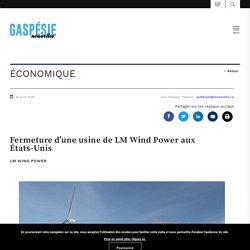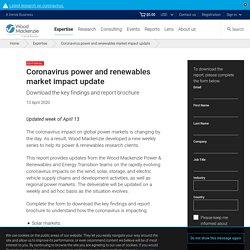

Fermeture d’une usine de LM Wind Power aux États-Unis. Partager sur les réseaux sociaux.

Accélérer la transition énergétique : le rôle de la finance verte et ses enjeux pour l’Europe. « Le défi de la finance verte est d’aligner les flux de capitaux sur les objectifs climatiques, en particulier ceux acquis à l’issue de la COP21 et de la signature de l’accord de Paris » (comme le prévoit l’article 2.1.c dudit accord(1)), rappelle une nouvelle étude du Centre Énergie-Climat de l'Ifri publiée le 15 avril.

De nombreux outils destinés à financer des actifs « verts » ont depuis été développés pour accompagner la transition bas-carbone. Global solar growth slides 18% as Covid-19 hits market: WoodMac. Global solar construction and development growth is slowing as countries enforce unprecedented Covid-19 lockdowns, according to analysts at Wood Mackenzie who cut their 2020 PV installation forecast by 18%.

The analyst group has downgraded it forecast for PV installations for 2020 from 129.5GW to 106.4GW. “Next year will also be a challenging one for solar,” warned WoodMac principal solar analyst, Tom Heggarty. “We assume that economic damage caused by the coronavirus pandemic and concurrent crash in oil prices will tip the world into recession in 2020.” Heggarty said that although it expects a strong economic recovery next year, that solar projects which should be delivered in 2021 are being developed and financed today.
Therefore when the recession hits, not all such activity will go ahead as planned. “Demand destruction will be offset to some degree by the spill-over of delayed projects from 2020 to 2021. Different sectors of the market will be impacted differently as well. Will Hydrogen Fuel Cells Play a Role in the VTOL Revolution? - Avionics. Hydrogen fuel cells provide some advantages over lithium-ion batteries, which have limited energy density.

But are they right for vertical lift? (MVRDV) Almost all players in the emerging urban air mobility industry have converged on the idea of using fully-electric aircraft, powered by lithium-ion batteries, to create affordable aerial transit options for relatively short distances. But a few companies continue to develop and advocate for the use of hydrogen fuel cells in VTOL aircraft, maintaining they hold innate advantages over lithium-ion batteries — primarily in energy density and lifespan — and are the superior choice. HyPoint, a venture-funded company in Menlo Park, Calif., has demonstrated an air-cooled hydrogen fuel cell powertrain that produces 1000 watts per kilogram of specific power with an energy density of 530 watt-hours per kg. The company’s next version of the product will reach 2,000 W/kg specific power and 960 Wh/kg energy density.
Most Solar Panel Warranties Last 25 Years. Europe's Plant Owners Are Counting on Much More. European solar asset owners are grappling with the prospect of longer-lived projects after a 2019 ruling upped the useful life of plants to 35 years.

The figure represents a big increase over the traditionally accepted lifespan of 25 years, which is based on standard PV panel warranty periods. The legal precedent appeared in a ruling against Spain by the World Bank’s International Centre for Settlement of Investment Disputes (ICSID) last September, following a lawsuit brought by solar investors OperaFund Eco-Invest and Schwab Holding over retroactive feed-in tariff cuts. In the fight to reduce its liability, Spain’s legal team had argued that solar plants had a 30-year lifespan. America’s Largest Municipal Utility Invests in Move from Coal to Hydrogen Power. The Los Angeles Department of Water and Power (LADWP), the largest municipal utility in the nation, is leading a $1.9 billion effort to develop the world’s first utility-scale hydrogen power plant.

The city is one of more than 150 across the country that have committed to 100 percent renewable power by 2050. LADWP will oversee the transformation of a coal-fired power plant to one that will run on “green” hydrogen — hydrogen produced using renewable energy. The project achieved a major milestone recently with the announcement that Mitsubishi Hitachi Power Systems (MHPS), had been awarded the contract to manufacture and service the turbines for the updated plant. The turbines are the most important ingredient in the project’s success. When they are put into operation in 2025, they will generate electricity using a mix of 30 percent hydrogen and 70 percent natural gas. La méthanation pourrait valoriser le CO2 d’épuration du biométhane. Le coronavirus et son impact à long terme sur l'énergie, une vision optimiste - Transitions & Energies.
BS2019 210716. Coronavirus power and renewables market impact update. Updated week of April 13 The coronavirus impact on global power markets is changing by the day.

As a result, Wood Mackenzie developed a new weekly series to help its power & renewables research clients. This report provides updates from the Wood Mackenzie Power & Renewables and Energy Transition teams on the rapidly evolving coronavirus impacts on the wind, solar, storage, and electric vehicle supply chains and development activities, as well as regional power markets. The deliverable will be updated on a weekly and ad hoc basis as the situation evolves. Complete the form to download the key findings and report brochure to understand how the coronavirus is impacting: